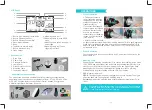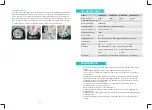
Power Output Control
select dial (14) decides different power output, satisfying light requirements in
different environment. The power is adjustable freely from 1/32 to 1/1 which will
be accordingly shown on the LCD display (10). "--" on the display indicates that
the flash triggering function is turned off. Press the Test button to discharge
power when the flash output is adjusted from high to low.
Test Button
To fire the flash without taking a picture, press the test button (4). It can also help
adjust the flash brightness when combined with the select dial (14). Press the
SET button and turn on the flash to view its version.
Sync Triggering
The sync cord jack (2) is a Φ6.35mm
plug. Insert a trigger plug here and
the flash will be fired synchronously
with the camera shutter.
GR/CH Button
Short press the GR/CH button can
adjust the built-in wireless group. When the group indicator on the LCD panel is
blinking, turn the select dial to change. And long press the GR/CH button can
adjust the built-in wireless channel. When the channel indicator on the LCD panel
is blinking, turn the select dial to change.
Slave Trigger Model
Three slave triggering models are available and can be set by pressing slave
model button (6).
◆
No optical control: S1 or S2 is not displayed on the LCD panel, indicating the
slave triggering function is shut down.
◆
One fire model: S1 is displayed on the LCD panel, indicating the flash will fire
synchronously when receiving one external flash. In this model, the flash can
function as an auxiliary lamp, offering various effects of light and shadow.
◆
Anti-preflash model: S2 is displayed on the LCD panel, indicating the flash will
receive two external flashes within 2 seconds and will fire synchronously when
receiving the second flash. In this model, the flash can function as an auxiliary
lamp, applicable to TTL system. With this anti-preflash function, the flash can
synchronize with cameras having a one-preflash firing system.
Buzz Function
The sound button (8) is used for deciding whether there is sound reminder for
ready flash after recharging. When the buzz indicator is on the LCD panel, the
buzz function is working; when it is disappear, the buzz function is not working. A
“BI” sound will be heard when it’s fully charged.
Key Combination
Synchronously press the GR/CH button and the S1/S2 button can turn on/off the
built-in wireless transmission. If there are no wireless and channel indicators
displayed on the LCD panel, the built-in wireless transmission is off. On the
contrary, the built-in wireless transmission is on. Synchronously press the S1/S2
button and BUZZ button to recover factory settings.
Alarm Display
E0 The temperature sensor is not connected.
E1 When charging, the capacitance and voltage are not rising within 1 second.
E2 The fastest heating-up component is over the extra temperature.
E3 Discharged capacitance and voltage
>
10%
Alarm sounds, BIBI, ringing per 0.5 second. Press SET button to stop alarming.
Memory Function
The device is equipped with memory function for the panel setting. It will help
remember the panel setting 3 seconds after you set it. When starting up the flash
next time, the panel setting will be the same as that before powering it off.
Wireless Control Function
The flash unit has built-in 2.4G wireless transmission, which can be used
together with
ST-III
and
PRO AC 2.4GHz
flash trigger.
◆
The flash unit is built in with a Wireless Control Port (9) so that you can
wirelessly control the on-and-off of your flash, modeling lamp and buzzer, as well
as adjust the flash output level, etc.
◆
To control the flash wirelessly, you need a
PIXAPRO
PRO AC
series remote
control set (on-camera and on-flash). Insert its receive end into the Wireless
Control Port (9) on the flash and insert the transmit end into the camera hot
shoe. Settings made on the hotshoe-mounted transmit and receive ends will be
wirelessly communicated to the flash. Then you can press the camera shutter-
release button to trigger the flash.
◆
For full instructions on the use of
PRO AC
series remote control, see its user
manual.
-
0
7
-
-
0
8
-
























